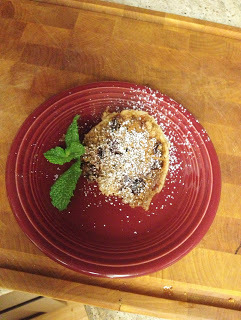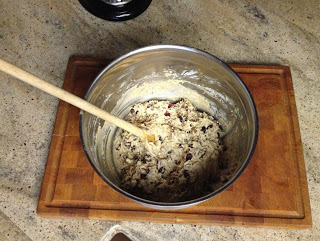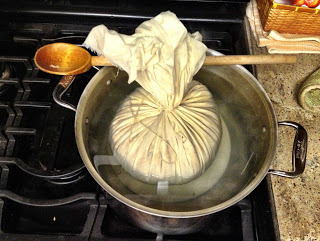Recipe: Scottish Dumpling
 My husband was lucky enough to inherit several handwritten recipes from his Scottish grandmother when she passed away. While he has fond memories of many of these dishes -- shortbread, lemon curd, Scottish pancakes -- there was one that has remained a mystery: Scottish Dumplings.
My husband was lucky enough to inherit several handwritten recipes from his Scottish grandmother when she passed away. While he has fond memories of many of these dishes -- shortbread, lemon curd, Scottish pancakes -- there was one that has remained a mystery: Scottish Dumplings.We have lived with this small, handwritten index card for years, but have never done anything with it. That is, until a few days ago after my husband assured me again that he had no recollection of such a dish and would not even be able to tell me if I had concocted it correctly if I tried it.
My curiosity got the better of me.
I did some research and discovered the more common name for Scottish Dumpling is Clootie Dumpling. "Clootie" means a strip of cloth or rag, and it was so named because the oldest forms of the recipe call for the dumpling -- which is much more like an English pudding -- to be boiled in a cloth.
Grandma Cameron's version called for cooking the dumpling in a bowl in a steamer with wax paper and foil, but try as I might, I could not figure out what I was supposed to do with the wax paper and aluminum foil.
So I compromised. I used Grandma Cameron's ingredients, and cooked them according to the traditional boiling method.
I don't know if my dumpling comes close to her version, but I do know it has become a welcome traditional Scottish treat in our house, and one that we'll definitely be having again.

Scottish DumplingAdapted from Nessie Cameron's family recipe.
3 cups flour, plus 2 tbls. 1 cup sugar
1 tsp. cinnamon
1 tsp. all spice
1/2 tsp. cloves
1/2 tsp. nutmeg
2 tsp. baking soda
1/2 tsp. salt
3 eggs
1/4 lb. butter, melted
1 apple, grated
1/2 lb. currants
1/2 lb. golden raisins
1/2 c. milk
 Sieve 3 cups of flour and the other dry ingredients into a large mixing bowl; add the fruit. Mix in the melted butter, eggs and milk. Invert a heat-proof plate in the bottom of a large soup pot, fill about two-thirds with water and bring to a boil. Dip a 20-inch square of muslin in the boiling water, remove and wring until just damp (use tongs, the cloth will be very hot). Spread the cloth out on the counter, dust the center with the remaining flour, and turn the batter out onto it. Pull the cloth ends together until you've made a little sack, with the dumpling batter in the center. Tie with kitchen twine, leaving a bit of room for the batter to expand as it cooks. Place the sack into the boiling water and lower the heat till it reaches a slow simmer. If the sack tail is long, straddle a wooden spoon across the pot and drape the tail to keep it away from the flame. Cook for three hours, replenishing the water as needed to keep the dumpling at least two-thirds covered.
Sieve 3 cups of flour and the other dry ingredients into a large mixing bowl; add the fruit. Mix in the melted butter, eggs and milk. Invert a heat-proof plate in the bottom of a large soup pot, fill about two-thirds with water and bring to a boil. Dip a 20-inch square of muslin in the boiling water, remove and wring until just damp (use tongs, the cloth will be very hot). Spread the cloth out on the counter, dust the center with the remaining flour, and turn the batter out onto it. Pull the cloth ends together until you've made a little sack, with the dumpling batter in the center. Tie with kitchen twine, leaving a bit of room for the batter to expand as it cooks. Place the sack into the boiling water and lower the heat till it reaches a slow simmer. If the sack tail is long, straddle a wooden spoon across the pot and drape the tail to keep it away from the flame. Cook for three hours, replenishing the water as needed to keep the dumpling at least two-thirds covered.

Remove the dumpling sack and place on a plate. Peel back the cloth. When the top of the dumpling is exposed, place another plate on top of it and invert so that you may carefully remove the sack from the bottom of the dumpling. This will be the presentation side of the dumpling, so peel carefully.
Allow the dumpling to sit for at least fifteen minutes to dry. Yields 10 servings.
 Suggestion: If you tear the dumpling skin and want to serve your dumpling intact, you may consider disguising the broken area with a glaze, or a dusting of powder sugar and strategically placed mint leaves.
Suggestion: If you tear the dumpling skin and want to serve your dumpling intact, you may consider disguising the broken area with a glaze, or a dusting of powder sugar and strategically placed mint leaves.
Published on December 07, 2012 08:21
No comments have been added yet.



